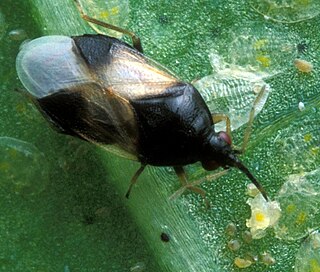
Tetranychus urticae is a species of plant-feeding mite generally considered to be a pest. It is the most widely known member of the family Tetranychidae or spider mites. Its genome was fully sequenced in 2011, and was the first genome sequence from any chelicerate.

Spider mites are members of the Tetranychidae family, which includes about 1,200 species. They are part of the subclass Acari (mites). Spider mites generally live on the undersides of leaves of plants, where they may spin protective silk webs, and can cause damage by puncturing the plant cells to feed. Spider mites are known to feed on several hundred species of plants.

Gerbera jamesonii is a species of flowering plant in the genus Gerbera belonging to the basal Mutisieae tribe within the large Asteraceae family. It is indigenous to South Eastern Africa and commonly known as the Barberton daisy, the Transvaal daisy, and as Barbertonse madeliefie or Rooigousblom in Afrikaans. It was the first species of Gerbera to be the subject of a scientific description, studied by J. D. Hooker in Curtis's Botanical Magazine in 1889.

Acaricides are pesticides that kill members of the arachnid subclass Acari, which includes ticks and mites. Acaricides are used both in medicine and agriculture, although the desired selective toxicity differs between the two fields.

Withania somnifera, known commonly as ashwagandha or winter cherry, is an evergreen shrub in the Solanaceae or nightshade family that grows in India, the Middle East, and parts of Africa. Several other species in the genus Withania are morphologically similar.

The Acariformes, also known as the Actinotrichida, are the more diverse of the two superorders of mites. Over 32,000 described species are found in 351 families, with an estimated total of 440,000 to 929,000 species, including undescribed species.

Ballooning, sometimes called kiting, is a process by which spiders, and some other small invertebrates, move through the air by releasing one or more gossamer threads to catch the wind, causing them to become airborne at the mercy of air currents and electric fields. A 2018 study concluded that electric fields provide enough force to lift spiders in the air, and possibly elicit ballooning behavior. This is primarily used by spiderlings to disperse; however, larger individuals have been observed doing so as well. The spider climbs to a high point and takes a stance with its abdomen to the sky, releasing fine silk threads from its spinneret until it becomes aloft. Journeys achieved vary from a few metres to hundreds of kilometres. Even atmospheric samples collected from balloons at five kilometres altitude and ships mid-ocean have reported spider landings. Ballooning can be dangerous.
Feltiella acarisuga is a species of predatory gall midges which will feed on various species of spider mites. It is especially common when spider mites occur in colonies. It requires a high spider mite density and high humidities to become established.

Tetranychus lintearius is a species of spider mite known as the gorse spider mite. It is used as an agent of biological pest control on common gorse, a noxious weed in some countries.

The Prostigmata is a suborder of mites belonging to the order Trombidiformes, which contains the "sucking" members of the "true mites" (Acariformes).

Aceria sheldoni, commonly called the citrus bud mite, is a species of mite belonging to the family Eriophyidae. It feeds in leaf- and flower-buds of Citrus spp., causing deformation to leaves, flowers and fruit, and is a worldwide pest of citrus fruit production.

Passiflora arborea is a species of passion flower found in Colombia, Ecuador and Panama. Passiflora arborea is a freestanding tree that can grow to be 50 feet tall. They germinate anywhere from an elevation of 1400 – 2000 ft. The tree's leaves grow to be 1 to 1½ feet long. It is native to Colombia, is rarely seen in cultivation, and is one of two species of Passiflora that is not widely distributed throughout the country.

Orius insidiosus, common name the insidious flower bug, is a species of minute pirate bug, a predatory insect in the order Hemiptera. They are considered beneficial, as they feed on small pest arthropods and their eggs. They are mass-reared for use in the biological control of thrips.
Neoseiulus californicus is a predatory mite that feeds on Tetranychid mites. This species was first described on lemons from California under the name Typhlodromus californicus in 1954.
Dicyphus hesperus is a species of true bug in the family Miridae. It is a generalist predator of other insects and also feeds on plant tissues. It is native to North America and has been used there in biological control of agricultural pests, especially whitefly on tomatoes.
Isaria fumosorosea is an entomopathogenic fungus, formerly known as Paecilomyces fumosoroseus. It shows promise as a biological pesticide with an extensive host range.

Oligonychus pratensis, the Banks grass mite, is a species of mite in the spider mite family. They are considered a pest and often infest corn and turf grasses.
Trombidium grandissimum, commonly known as the giant red velvet mite, is a species of mite in the genus Trombidium in the family Trombidiidae. This common mite is endemic to northern and central India, especially in the central plateau, and it primarily inhabits arid regions. T. grandissimum live on the ground and often hidden among soil, but is commonly seen during the rainy season or after recent rain events, and therefore has the nickname of "rain bug".













